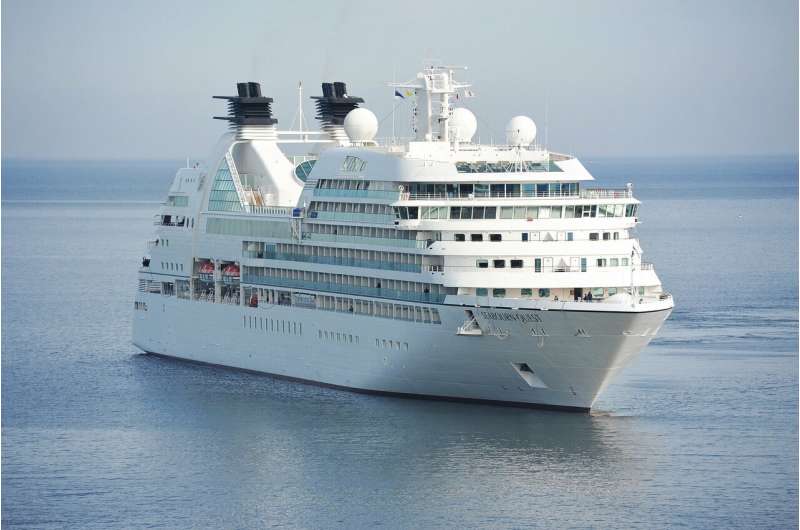Credit: CC0 Public Domain
During a cruise last month, I experienced a version of Murphy's Law for the era of remote work: when I needed the Wi-Fi most, it stopped working.
I was due to conduct a video interview while on a transatlantic sailing from the Netherlands to New York a few days into the trip, and the internet connection had been reliable, if not speedy. But a couple of hours before the meeting time, as we sailed away from our stop in England toward the United States, the already sluggish connection came to a complete halt.
I spent the next 90 minutes or so frantically refreshing my browser window and trying to contact my colleagues to see if anyone might be able to attend in my place. I was finally able to reach my editor via the phone in my stateroom, and my coworker kindly filled in for me.
As more companies have adopted a remote or hybrid work model in the wake of the pandemic, employees are doing their jobs from a wide range of places, including while traveling. Among U.S. companies, 74% currently have or plan to use a permanent hybrid work model, and 44% of employees in America "prefer a hybrid work model," according to research compiled by Zippia.com.
While I covered the Holland America Line voyage from Rotterdam in the Netherlands, I set out to see whether I could work and sail across the Atlantic Ocean. And while experiences may differ from cruise to cruise, much like the waves outside rocked the ship, there were ups and downs.
Here's what I learned about working remotely on a transatlantic voyage.
Is cruise Wi-Fi good enough to work from?
When I boarded the ship on Oct. 15, I was able to connect my devices to the ship's Wi-Fi network easily. I paid for the premium package for the duration of the trip—through Oct. 27—that allowed me to connect up to four devices for about $320.
The connection was largely reliable but overall slower than my home or office Wi-Fi, which I expected. However, the connection became especially slow at random points throughout the trip in unpredictable ways. For instance, about four days into the cruise, I tried working in Google Docs only to have it repeatedly stall as it was "trying to connect," even as other websites seemed to load fine.
While I was able to download photos easily, I had trouble uploading photos to our content management system. Making calls was also a bit challenging. When I used my phone's Wi-Fi calling feature, the connection was spotty, and I experienced an audio delay through WhatsApp, though the call quality was better.
Working offline as much as possible provided a workaround, by switching from Google Docs to Microsoft Word, for instance, and downloading any necessary files during periods when the internet was the strongest.
The connection's lags were always temporary, as well, and connectivity usually returned to its full functionality within a few minutes or hours.
Time zones can be confusing
During our cruise, we repeatedly changed time zones. Because we were going from Europe to the U.S., we gained time and set our clocks back one hour a total of five times.
That meant extra-long nights of sleep, but proved a puzzle with ever-changing pieces as I tried to keep track of how far removed I was from my usual working hours. For the first part of the cruise, for example, I got up in the morning as most of my colleagues were likely fast asleep, but by the end, we were back in the same time zone.
While I typically keep track of time using my cell phone, it stopped automatically updating as we got farther from land. However, the home page of Holland America's Navigator app always displayed the current ship time, as did my stateroom's TV, and I manually changed the time on my phone accordingly.
And when in doubt, searching the local time in a given place on Google is a quick and easy way to double-check time differences.
Some areas of the ship are better for working than others
Like many modern cruise ships, Holland America's Rotterdam had no shortage of activities, from lectures and fitness classes to games like bingo. Those were particularly useful on sea days, of which a transatlantic cruise has many, but also meant some parts of the ship were less conducive to working at certain times.
I snagged a spot in a plush chair at the Crow's Nest on Deck 12 one afternoon and worked for about half an hour before the host of a trivia game began reading questions over the loudspeaker. After trying in vain to compete with the sound by turning up the music in my headphones, I retreated to my stateroom.
The ship's daily programs distributed to cabins included a list of activities with times and locations, and can help passengers determine which locations might be quieter than others. Rotterdam also had an on-board library and an internet center with computers.
I primarily worked in my stateroom, which had a desk with more than enough room for my laptop and other items like a notepad, power outlets, and a view of the ocean.
Despite the challenges, while on board, I was able to turn in stories, communicate with my colleagues (much of the time), and do most of the usual functions of my job from an unlikely place.
(c)2022 USA Today
Distributed by Tribune Content Agency, LLC.






















